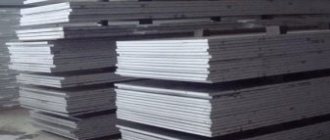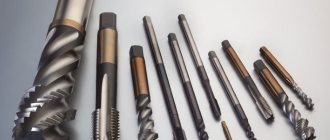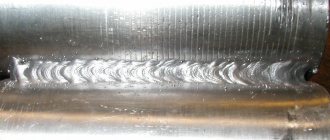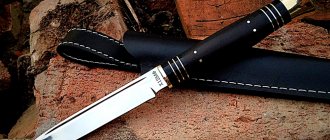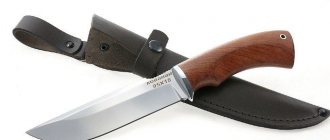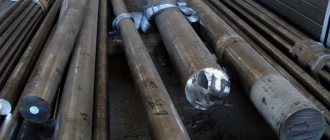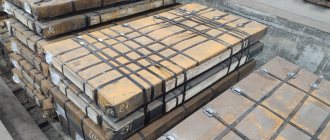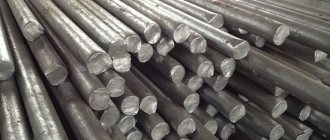Decoding
Steel grade 10HSND indicates its chemical composition. It reflects the 5 main elements that have the greatest impact on the properties of steel. Other chemical elements may also be present in the alloy, but in strictly limited quantities, beyond which they are displayed in the marking.
- 10 – indicates the carbon content in hundredths (0.10%). Depending on the percentage of carbon in the steel, its mechanical properties can vary significantly. High-carbon steels are characterized by increased strength and hardness, in contrast to this, ductility and resistance to impact loads are reduced. Steels with a low carbon content are considered “soft”; they are ductile, have excellent toughness, but are not hard.
- X – chromium (up to 0.9%). Chromium steels are resistant to corrosion; a high percentage of chromium in the composition makes the alloy stainless. Chromium is one of the most accessible and widespread alloying elements. It also affects the mechanical properties of steel, giving it hardness and strength, while reducing ductility to a small extent.
- C – silicon (up to 1.1%). Silicon gives the metal resistance to acidic environments, scale resistance and increases elasticity.
- N – nickel (up to 0.8%). The alloying additive is close to chromium in its effect on the quality of the metal. Gives steel anti-corrosion properties, increases strength and ductility.
- D – copper (up to 0.6%). Increases corrosion resistance.
In addition to the elements indicated in the grade, the following can be found in steel: sulfur, phosphorus, aluminum, manganese, tungsten, vanadium, cobalt, molybdenum, titanium, nitrogen, arsenic and other minor impurities.
Material 10HSND Ekaterinburg
Not a single production can operate without steel, be it heavy engineering or the manufacture of household electrical appliances. There are many brands of this product, as well as a large number of dispensing forms. Our company sells 10HSND material in large quantities and with a minimal margin. To clarify the properties and characteristics of a particular brand, you can contact the company’s managers.
Like all products, 10HSND material is purchased from leading manufacturers. Therefore, we are ready to provide a quality guarantee with full responsibility. The minimum number of intermediaries determines the low cost. Coupled with fast delivery, this enables our business partners to conduct stable and mutually beneficial cooperation.
In addition to tempering, in the form of one or another part (blank), our company carries out metal processing. All events undergo strict control for compliance with GOST and rules. The specialists of our company carry out such work as galvanizing, creating parts according to customer drawings, producing castings, manufacturing various profiles and much more.
Having the latest equipment and vast experience in our arsenal, we can offer product testing for a number of parameters, such as strength characteristics, chemical composition, alloy purity, and so on.
Each buyer is offered a huge range of products in various formats, as well as current services and works. To quickly understand and choose a product that meets your needs, you need to contact the company manager and receive detailed information on all issues of interest.
Chemical composition
Chemical composition, % (GOST 19281-89)
| C, no more | Si | Mn | Cr | Ni | Cu | P | S | N | As |
| no more | |||||||||
| 0,12 | 0,8-1,1 | 0,5-0,8 | 0,6-0,9 | 0,5-0,8 | 0,4-0,6 | 0,035 | 0,040 | 0,008 | 0,08 |
Chemical composition, % (GOST 19281-2014)
| C, no more | Si | Mn | P | S | Cr | Ni | Cu | V | other elements |
| no more | |||||||||
| no more than 0.12 | 0,8-1,1 | 0,5-0,8 | 0,03 | 0,035 | 0,6-0,9 | 0,5-0,8 | 0,4-0,6 | no more than 0.12 | — |
Electrodes for welding low alloy steel
Welding low-alloy steels , which have a yield strength of no more than 390 MPa, does not seem difficult. It is practically no different from welding low-carbon steels.
Steels of this type are not hardened and are not prone to overheating, which leads to a decrease in plastic properties. However, it is worth remembering that as the carbon content increases, the properties of steel change. For example, steels 15KHSND and 14G2 contain 0.18% carbon and have a tendency to form hardening structures and overheat in the temperature-influenced zone. For these reasons, when welding steels of this type, it is necessary to select an optimal mode that will not allow the formation of hardening structures and overheating of the metal structure. Welding is carried out using electrodes with a diameter of 4 - 5 millimeters. The welding process takes place in several balls. If the thickness of the metal being welded exceeds the thickness of 15 millimeters, then welding is carried out using the block method or cascade, however, the metal in the welding zone is not heated to a high temperature in order to prevent overheating of the affected zone.
For welding popular low-alloy steels 15HSND and 14G2, welding electrodes E55 and E50A are used, which must be calcined before use. When welding steels 09G2S, 14G2 and 10G2S1, electrodes containing 18 percent carbon are used. These electrodes are E42 and E50A. Carrying out welding work with steels with a yield strength of more than 390 MPa requires more attention. Steel with such properties is prone to the formation of crystallization cracks, but it is less susceptible to overheating of the heat-affected zone because it is alloyed. Welding of such steel is performed with electrodes E60, E50A and E55. E60 welding electrodes are used for welding low-alloy steel in all spatial positions of the weld, and to work with them you need to use direct current of reverse polarity.
For welding these types of steels, you can use electrodes UONI 13/55 , PSK-50 and SK"-50 . Low-alloy types of steel must be carefully prepared for welding before welding. They need to be cleaned of rust and various types of contaminants. The metal being welded and its adjacent parts must be cleaned to 20 millimeters. In addition, all sagging parts of the metal and protrusions must be processed with an abrasive tool and become flush with the rest of the metal. If the thickness of the metal being welded is more than 25 millimeters, then welding must be done using local heating at a temperature of 120 - 160 degrees. However, if the ambient temperature is -15 degrees Celsius or lower, then preliminary local heating of the metal is mandatory, regardless of the thickness of the product being welded or its shape and weight. Thus , by maintaining the required metal temperature during welding, you will be able to carry out the welding process of low-alloy steels successfully .
Source
Characteristics and Features
The steel has high performance characteristics: it is suitable for all types of welding, and has an advantage over ordinary carbon steels, because contains alloying additives that protect it from the adverse effects of the external environment. Steel 10HSND does not lose strength after tempering and retains its properties under temperature changes. The plasticity of the material makes it convenient for processing by any means.
Advantages and disadvantages
The advantages of 10HSND steel include:
- Resistance to corrosion and oxidation, which allows the use of steel in conditions of high humidity and acidic environments.
- Possibility of operation in a wide temperature range from -70 to +450 degrees.
- Weldability in all ways.
- Low cost due to the simplicity of the production process and the absence of expensive alloying components.
The disadvantage of steel is that it contains harmful impurities - phosphorus and arsenic.
Hand over alloy 10HSND (GOST 19281 - 89) in St. Petersburg
Steel, low-alloy structural for welded structures
10KhSND is a metal alloy based on iron (Fe) , its content in 10KhSND must be at least 95.5%. The 10HSND alloy must contain silicon, chromium, manganese, nickel, and copper. The permissible amount of impurities is determined in the chemical composition table.
- Urgently! Alloys AMS5537 (L-605), AMS5536 (Hastelloy X)
- Urgently! Nickel N-1 (cathode sheets)
- Urgently! Railway rails - scrap, liquid scraps
- purchase non-ferrous metals and alloys
- purchase ferrous metals, steels and alloys
- purchase non-ferrous metals and alloys
- purchase ferrous metals, steels and alloys
- sell ferrous metals, steels and alloys
- sell ferrous metals, steels and alloys
- purchase ferrous metals, steels and alloys
- purchase ferrous metals, steels and alloys
- sell non-ferrous metals and alloys
- sell non-ferrous metals and alloys
- sell petroleum products and their waste
- purchase non-ferrous metals and alloys
- sell non-ferrous metals and alloys
- sell semiconductors, non-metals and their compounds
- sell non-ferrous metals and alloys
All ads + Add yours Useful tools
- Determine the brand Determine the alloy by composition
- Pipe or angle weight Metal calculator
- For scrap acceptors Calculation of the profitability of the transaction
Determine the alloy by chemical composition Determine the mass by the shape of the product Calculate the profitability of the transaction
Processing methods
10HSND steel is weldable well, but the presence of alloying additives in the composition has a certain effect on weldability. Thus, quenching stress may arise in the welding zone, increasing the risk of cold cracking in some cases. The vulnerability of joints to hot cracking may also increase depending on a number of other factors. If heat-treated metal is welded, a loss of strength occurs in the welded area. It is quite difficult to maintain the impact toughness of the weld metal and the area around the weld. When overheated, a coarsening of the austenite grain is observed, a Widmanstätten structure is formed, the fragility of the ferrite base increases, chemical heterogeneity develops, and the weld becomes prone to brittleness. Negative consequences can be avoided or their impact can be reduced using subsequent heat treatment or welding techniques.
Also, 10HSND steel is suitable for processing by basic methods: forging, cutting, mechanical tooling, etc. No special tools are required for cutting steel; its mechanical properties allow it to be processed without additional conditions. Forging is carried out at temperatures ranging from 1200C to 850C. The metal after forging is not sensitive to flocking and is not prone to temper brittleness.
Heat treatment of welded parts
The main task that heat treatment solves is the removal of residual stresses that arise during welding. As a result of this treatment, the structure of the metal and the properties of the weld should improve.
This treatment is carried out immediately after completion of welding work. In this case, it is very important to prevent overcooling of the welded workpieces. The minimum permissible temperature should not fall below the heating temperature. In the event that it is not technically possible to perform heat treatment, then it makes sense to perform thermal rest.
To perform heat treatment operations, certain preparations are required. In particular, parts intended for processing must be placed on a special pallet in accordance with the requirements of the technological map. After laying, the pallet is placed in the oven.
At the time of loading, the oven must be either cold or heated to a temperature of 300 ºC. The parts should be in the oven for about 1 - 2 hours. After this time, the oven can be heated further. The maximum temperature should not exceed 590 ºC, and the heating rate should be 70 ºC per hour. The parts must remain at a temperature of 590 ºC for at least three hours. Cooling must be done at a rate of 50 ºC per hour to 250 ºC.
Serious enterprises operate a quality control system. That is, the entire heat treatment process is recorded in special logs and the furnace parameters are constantly recorded. Measurements are carried out using a pyrometer. This approach allows us to obtain high quality products.
Application area
Steel 10HSND is a structural steel, intended for the manufacture of metal structures and mechanisms. The main areas of its application are the following:
- Construction. Welded and non-welded structures, large-sized structures, load-bearing elements of buildings, bridge construction (arches and bridge spans).
- Mechanical engineering. Mainly used for the production of mechanisms for heavy construction and road equipment, as well as forestry machines.
- Production of mining equipment. Buckets and bucket parts are made from 10HSND steel.
- Production of waste processing equipment. Shredder knives, linings, hydraulics.
Steel 10HSND structural chrome-silicon-nickel low-alloy
Steel 10HSND is a structural chromium-silicon-nickel low-alloy steel. Decoding steel indicates the following characteristics. The first two-digit number indicates the approximate carbon content, the letters indicate the presence of chemical elements, as indicated by the state standard, X - the presence of chromium, C - silicon, H - nickel and D - copper. A similar alloy is produced in the form of rolled sheets, angles, channels, strips, bars and pipes of various diameters.
Type of delivery
Types of supply of material 10HSND
| B22 – Long and shaped rolled products | GOST 8239-89; GOST 26020-83; GOST 9234-74; GOST 8509-93; GOST 8510-86; GOST 8240-97; GOST 8278-83; GOST 8281-80; GOST 8282-83; GOST 2591-2006; GOST 2590-2006; GOST 11474-76; GOST 25577-83; GOST 14635-93; GOST 19425-74; GOST 19771-93; GOST 19772-93; GOST 13229-78; GOST 21026-75; GOST 8283-93; |
| B23 - Sheets and strips | GOST 103-2006; GOST 82-70; GOST 6713-91; GOST 19903-74; GOST 17066-94; |
| B33 - Sheets and strips | GOST 19282-73; GOST 10885-85; |
| B62 — Steel pipes and connecting parts for them | GOST 20295-85; GOST 24950-81; |
Mechanical properties
| GOST | Delivery status | Section, mm | conditional yield strength σ0.2, MPa | tensile strength σв, MPa | relative elongation after rupture δ5(δ4), % |
| no less | |||||
| GOST 19281-89 | Long and shaped rolled products | Up to 15 incl. | 390 | 530 | 19 |
| GOST 19282-89 | Leaf and strip | St.15 to 32 incl. | 390 | 530 | 19 |
| St.32 to 40 incl. | 390 | 530 | 19 | ||
| GOST 17066-94 | Hot rolled sheet | From 2 to 3.9 incl. | — | 530 | (15) |
Mechanical properties at elevated temperatures
| tsp, °С | conditional yield strength σ0.2, MPa | temporary tensile strength σв, MPa | relative elongation after rupture δ5, % | relative narrowing ψ, % |
| 20 | 410 | 540 | 36 | 71 |
| 100 | 360 | 500 | 33 | 71 |
| 200 | 330 | 470 | 28 | 70 |
| 300 | 305 | 480 | 28 | — |
| 400 | 295 | 490 | — | — |
| 500 | 265 | 370 | 30 | 77 |
| 600 | 195 | 215 | 35 | 87 |
| 700 | 140 | 160 | 47 | 94 |
| 800 | 59 | 78 | 71 | 87 |
| 900 | 59 | 78 | 70 | 95 |
Mechanical properties during tensile testing of long and shaped rolled products made of 10HSND steel (GOST 19281-2014)
| Strength class | Rolled cross-section dimensions, mm | steel grade | Mechanical properties, no less | ||
| yield strength σ0.2, MPa | temporary resistance σв, MPa | relative elongation δ5, % | |||
| 345 | Up to 20.0 incl. St. 20.0 to 140.0 | 10HSND | 345 | 480 | 21 |
| 375 | Up to 20.0 incl. St. 20.0 to 50.0 | 375 | 510 | 21 | |
| 390 | Up to 20.0 incl. St. 20.0 to 50.0 | 390 | 530 | 18 | |
Mechanical properties during tensile testing of thick sheets, wide-band universal rolled products and bent sections made of steel 10ХСНД (GOST 19281-2014)
| Strength class | Product thickness, mm | steel grade | Mechanical properties, no less | ||
| yield strength σ0.2, MPa | temporary resistance σв, MPa | relative elongation δ5, % | |||
| 375 | Up to 50.0 incl. | 10HSND | 375 | 510 | 21 |
| 390 | Up to 50.0 incl. | 390 | 510 | 19 | |
Impact strength of long and shaped steel
| Strength class | Rolled cross-section dimensions, mm | steel grade | Impact strength, J/cm2, not less, at test temperature, °C | |||||||||
| -20 | -30 | -40 | -50 | -60 | -70 | 0 | -20 | -40 | After mechanical aging +20(-10/+15) | |||
| KCU | KCV | KCU | ||||||||||
| 390 | From 5.0 to 10.0 incl. | 10HSND | 49 | 49 | 49 | 34 | 34 | 34 | + | + | + | 29 |
Impact strength KC at subzero temperatures
| GOST | Delivery status | Section, mm | KSU, J/cm2 at temperature, °C | |
| -40 | -70 | |||
| KSU | ||||
| GOST 19281-89 | Long and shaped rolled products | From 5 to 10 | 49 | 34 |
| From 10 to 15 incl. | 39 | 29 | ||
| KSV | ||||
| GOST 19281-89 | Leaf and strip | From 5 to 10 | 49 | 34 |
| From 10 to 15 incl. | 39 | 29 | ||
| St. 15 to 32 incl. | 49 | 29 | ||
| St. 32 to 40 incl. | 49 | 29 | ||
Endurance limit in hot-rolled state
| Thickness, mm | σ-1, MPa | τ-1, MPa |
| 4-32 | 284 | 167 |
| 33-40 | 274 | 167 |
Description
Steel 10HSND is used : for the manufacture of elements of welded metal structures and various parts that are subject to requirements for increased strength and corrosion resistance with limited weight and operating at temperatures from -70 to +450 ° C; rolled products intended for the manufacture of bridge structures of conventional and northern design; load-bearing elements of various welded structures; parts of pipeline fittings after hardening and tempering; as the main layer in the production of hot-rolled two-layer corrosion-resistant sheets.
Note
Low-alloy chromium-silicon-nickel steel with copper. Degree of deoxidation - Sp. Steel 10HSND provides the strength class of long, strip and shaped rolled products KP 390 with a thickness of up to 15 mm. Steel 10HSND provides the strength class of sheets, wide-band universal rolled products and bent profiles KP 390 with a rolled thickness of up to 40 mm. without the use of additional strengthening treatment.
Technological properties
| Forging temperature, °C | start 1200, end 850. |
| Weldability | Weldable without restrictions. Welding method - RDS, ADS submerged arc and gas shield, ESW. |
| Machinability | Kvtv.sp. = 1.12 and Kvb.st = 1.4 in the normalized and tempered state σв = 560 MPa |
| Tendency to temper brittleness | less inclined. |
| Flock sensitivity | insensitive. |
Brands of imported materials used in welded joints with steel 10HSND (STO 00220368-011-2007)
| Structural class | Steel grades | Brands of imported materials according to foreign standards |
| Pearlitic | 10HSND | ASTM SA-455 Gr70, ASTM SA-515 Gr70, ASTM SA-516 Gr70, ASTM SA-537 Gr70, ASTM SA-662 GrA(C), ASTM SA-662 GrB, ASTM SA-737 GrB, ASTM SA-738 GrA , ASTM SA-333 Gr3(6), ASTM SA-350 GrLF2, API 5L X56-65 |
The use of 10HSND steel in the manufacture of welded joints of pipeline fittings (ST TsKBA 025-2006)
| Material grade | Temperature of the working medium (wall), °C |
| 10HSND GOST 19281 | -70 to 475 |
Welding materials used in electric arc welding of steel 10HSND (ST TsKBA 025-2006)
| Base material grade | Electrode type according to GOST, TU (recommended brands of electrodes) | Application temperature, °C | Additional instructions |
| 10HSND GOST 19281 | E50A GOST 9467 (UONI-13/55) | Not lower than -60 | — |
| Below -60 to -70 | After welding heat treatment - normalization plus tempering | ||
| E50A GOST 9467 (VP-4, VP-6) | Below -60 to -70 | — |
Welding materials used for steel 10HSND when welding in shielding gases (ST TsKBA 025-2006)
| Grade of welded steel | Brand of welding wire according to GOST 2246, TU, recommended shielding gas or mixture of gases | Application temperature, °C | Additional instructions |
| 10HSND | Sv-08G2S Argon GOST 10157, carbon dioxide GOST 8050 or a mixture of argon and carbon dioxide ((75-85)% Ar + (15-25)% CO2) | Not lower than -40 | — |
| Below -40 to -70 | Subject to normalization plus vacation | ||
| Sv-08G2SNTYUR TU 14-1-3648 CO2, Ar, CO2 +Ar, | Not lower than -70 | — |
Welding materials for submerged arc welding of steel 10HSND (ST TsKBA 025-2006)
| Grade of welded steel | Wire grade according to GOST 2246, TU, Recommended flux grade according to GOST 9087 | Application temperature, °C | Additional instructions |
| 10HSND | Sv-10NYU TU 14-1-2219 Sv-10NMA, Sv-08GA, Sv-08G2S AN-348A, OSC-45, ANC-1 | Not lower than -60 | — |
| Below -60 to -70 | After welding heat treatment - normalization plus tempering |
Welding materials for welding steel 10ХСНД with dissimilar steels (ST TsKBA 025-2006)
| Grades of welded steels | Welding materials | Additional instructions | ||
| Electrodes, type according to GOST 10052 (recommended brands) | Welding wire, GOST 2246 or TU | |||
| Group A | Group B | |||
| 10Х18Н9Л 12Х18Н9ТЛ GOST 977 08Х18Н10Т 12Х18Н9Т 12Х18Н10Т 12Х18Н9 GOST 5632 08Х18Н10Т-ВД TU 14-1-3581 10Х18Н9 10Х18Н9-ВД 10Х18Н9-Ш Т U 108.11.937 15Х18Н12СЧТУ (EI 654) GOST 5632 10Х17Н13М3Т (EI 432) 10Х17Н13М2Т (EI 448) GOST 5632 | 10HSND | E-10Kh15N25M6AG2 (EA-395/9) E-10Kh25N13G2 (OZL-6, ZIO-8), E-11Kh15N25M6AG2 (NIAT-5, TsT-10) | Sv-07Х23Н13 | The welded joint is of unequal strength |
| E-10Х15Н25М6AG2 (EA-395/9) 582/23, 855/51 | Sv-10X16N25AM6 Sv-06X15N35G7M6B Sv-03X15N35G7M6B | The welded joint is of unequal strength. Welding materials are used for products under the jurisdiction of Rostechnadzor | ||
Temperature of preliminary and accompanying heating and tempering when welding structures made of steel 10HSND (ST TsKBA 025-2006)
| Grades of welded steels | Thickness of welded edges, mm | Temperature of preliminary and accompanying, °C | Interval between the end of welding and the start of tempering, hour | Temperature, °C | |
| welding | surfacing with austenitic class materials | ||||
| 10HSND | Up to 30 | Not required | Not required | Not limited | Not required |
| Over 30 | 150 | 150 | 630-660 | ||
The use of steel 10HSND for the manufacture of pressure vessels (PB 03-576-03)
| Steel grade, standard or specification designation | Technical requirements | Working conditions | Test types and requirements | |
| Wall temperature, °C | Medium pressure, MPa (kgf/cm2), no more | |||
| Sheet steel | ||||
| 10HSND, GOST 19281 | GOST 19281 | -40 to 400 | Not limited | GOST 19281 |
NOTE:
- Sheets in accordance with GOST 19281 must be supplied with mandatory compliance with paragraphs. 2.2.1,2.2.2, 2.2.3, 2.2.7, 2.2.9, 2.2.12 GOST, and the macrostructure must be monitored in accordance with GOST 5520 from a batch of sheets.
- Tests are carried out sheet by sheet at operating temperatures below -30 °C, above 200 °C or at a pressure of more than 5 MPa (50 kgf/cm2) with a sheet thickness of 12 mm or more.
- GOST 19281 applies to rolled products made of high-strength steels used for vessels that are not subject to heat treatment. The possibility of using rolled steel in accordance with GOST 19281 for vessels subjected to heat treatment must be agreed upon with a specialized research organization.
Thermal conductivity coefficient λ W/(m*K)
| Steel grade | λ W/(m*K), at test temperature, °C | |||||||
| 20 | 100 | 200 | 300 | 400 | 500 | 600 | 700 | |
| 10HSND | — | 40 | 39 | 38 | 36 | 34 | 31 | 29 |
Young's modulus (normal elasticity) E, GPa
| Steel grade | At test temperature, °C | |||||||||
| 20 | 100 | 200 | 300 | 400 | 500 | 600 | 700 | 800 | 900 | |
| 10HSND | — | 197 | 201 | 195 | 188 | 180 | 169 | 156 | 135 | 123 |
Analog (substitute) of steel grade 10HSND GOST 6713-91:
steel grade 10KHSNDA, S390, 14G2AF, 15KHSND, 15KHSNDA, S440, 16G2AF
Additional conditions for rolled metal products at the request of the Buyer in accordance with GOST, TU, etc. NTD: 1. 100% UZK 0, 1, 2, 3 continuity classes in accordance with GOST 22727-88. 2. Trim edge. 3. Flatness: high, especially high. 4. Heat treated: controlled rolling, normalizing, high tempering, high tempering. 5. Z-properties according to GOST 28870-90, relative narrowing in the direction of the thickness of the rolled product, no less than 15%, 25%, 35%.
Products group:
| NAME | PRICE | |||
